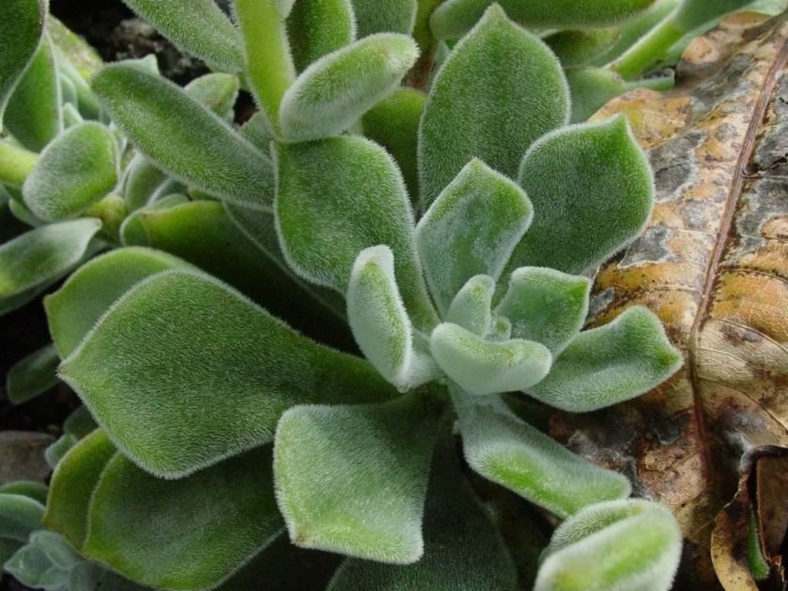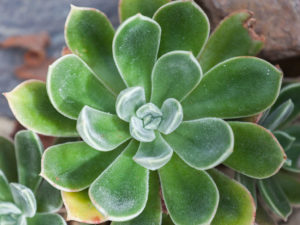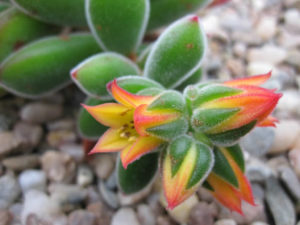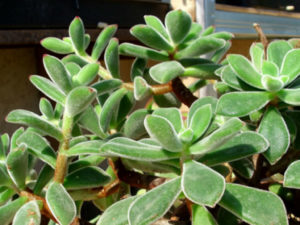Scientific Name
Echeveria pulvinata Rose
Common Name(s)
Chenille Plant, Plush Plant
Synonym(s)
Cotyledon pulvinata, Echeveria pulvinata var. pulvinata
Scientific Classification
Family: Crassulaceae
Subfamily: Sempervivoideae
Tribe: Sedeae
Genus: Echeveria
Etymology
The specific epithet "pulvinata" (pronounced "pul-vin-AH-tuh") means "cushion-shaped" and refers to the cushion-like leaves of this species.
Origin
Echeveria pulvinata is native to Mexico (Oaxaca).
Description
Echeveria pulvinata is an attractive shrubby succulent with branches topped with rosettes of green, spoon-shaped leaves densely covered with fine, short hairs. It can grow up to 4 inches (12 cm) tall. The young branches and sepals also have a velvet covering. The fleshy leaves are obovate, tapering to a narrow base, and tipped with a short, abrupt point. They can measure up to 1.2 inches (3 cm) in length, 0.8 inches (2 cm) in width, and 0.25 inches (0.6 cm) in thickness.
The scarlet flowers appear in leafy racemes in spring (sometimes later). They are urn-shaped, sharply 5-angled, and can reach a length of 0.8 inches (2 cm).
Varieties, Cultivars, and Hybrids of Echeveria pulvinata
- Echeveria pulvinata var. frigida
- Echeveria pulvinata 'Devotion'
- Echeveria pulvinata 'Ruby'
- Echeveria 'Giant Mexican Firecracker'
- Echeveria 'Graessneri'
- Echeveria 'Kircheriana'
- Echeveria 'Pulvicox'
- Echeveria 'Pulv-Oliver'

Hardiness
USDA hardiness zone 9b to 11b: from 25°F (-3.9°C) to 50°F (10°C).
How to Grow and Care
Most common Echeveria species are not complicated succulents to grow, provided you follow a few basic rules. First, never let water sit in the rosette, as it can cause rot or fungal diseases that will kill the plant. Additionally, remove dead leaves from the bottom of the plant as it grows. These dead leaves provide a haven for pests, and Echeverias are susceptible to mealybugs. Finally, as with all succulents, maintaining careful watering habits and providing ample light will help ensure success.
Most Echeveria can be easily propagated from leaf cuttings, although a few are better propagated from seeds or stem cuttings. Place the individual leaf in a succulent or cacti mix to propagate a leaf cutting, and cover the container until the new plant sprouts.
Repot as needed, preferably during the warm season. To repot a succulent, ensure the soil is dry before repotting, then gently remove the pot. Knock away the old soil from the roots, removing any rotted or dead roots. Treat any cuts with a fungicide.
See more at How to Grow and Care for Echeveria.
Links
- Back to genus Echeveria
- Succupedia: Browse succulents by Scientific Name, Common Name, Genus, Family, USDA Hardiness Zone, Origin, or cacti by Genus
Photo Gallery
Click on a photo to see a larger version.


